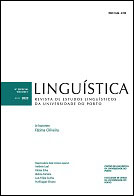"Chacun" in Portuguese and "cada qual" in French: diversification and neutralisation
Abstract
Portuguese and French language systems have many common features, but it is well-known that each language has its peculiarities. The asymmetry between the universal quantifier pronoun chacun in French and the three Portuguese pronouns cada um, cada qual and cada raises challenges of equivalence between these two Romance languages. Choosing a Portuguese equivalent of chacun presents the translator with a challenge that Koller (1992) refers to as ‘diversification’ (one-to-many relationship). Conversely, choosing a French equivalent of cada qual results in a loss of its peculiar features compared to cada um (the most frequent) and the exclusively floating quantifier cada. This ‘neutralisation’ (several-to-one relationship) can be compensated for by the translator (ibid.). Admittedly, cada qual is much rarer than cada um, but this pronoun is very intriguing for a French speaker, who wonders how professional translators in search of equivalence react when confronted to diversification of chacun and neutralisation of cada qual. The analysis of two aligned bilingual corpora consisting of FR-PT segments (translation memories) provides some answers to these questions. The first one consists of 378 segments containing chacun and its Portuguese equivalents. These segments were extracted from a journalistic corpus (MondeDiplomatique.v1, Per-Fide 2012). The second consists of 89 segments containing cadaqual and its French equivalents. These segments come from translation memories of EU institutions, also made available to the public by the Per-Fide project. Not surprisingly, cada um is the most frequent equivalent of chacunand chacun is the most frequent equivalent of cada qual. But the solutions to the challenges raised by diversification and neutralisation are varied and even go beyond the framework of universal quantification. This finding confirms the diversity of factors involved in the choices of professional translators.
References
Almeida, J. J., Araújo, S., Simões, A., & Dias, I. (2014). The Per-Fide corpus: A new resource for corpus-based terminology, contrastive linguistics and translation studies. In T. B. Sardinha, & T. L. São Bento Ferreira (Éds.), Working with Portuguese Corpora (pp. 177-200). Bloomsbury Academic.
Bacquelaine, F. (2014). Apports de la sémantique et de la syntaxe à la traduction des quantificateurs universels français et portugais. In I. Oliveira (Éd.), Terminologie, traduction et rédaction technique : des ponts entre le français et le portugais (pp. 55-71). Éditions Lambert-Lucas.
Bacquelaine, F. (2016). Approche sémantique contrastive du quantificateur universel portugais cada et français chaque. In E. Buchi, J.-P. Chauveau, & J.-M- Perriel (Éds.), Actes du XXVIIe Congrès international de linguistique et de philologie romanes (Nancy, 15-20 juillet 2013) (pp. 867-877). Éditions de linguistique et de philologie.
Bacquelaine, F. (2018). Particularités du quantificateur universel portugais cada. In F. Oliveira, A. Leal, M. F. H. Silva, & M. P. Silvano (Eds), Para Óscar Lopes: Estudos de Linguística (pp. 115-144). Edições Afrontamento.
Bacquelaine, F. (2020) Traduction humaine et traduction automatique du quantificateur universel portugais cada en français et en anglais : étude de phraséologie comparée [Thèse de doctorat non publiée]. Université de Porto.
Baker, M. (2011). In Other Word. A Coursebook on Translation (2e éd.). Routledge.
Junker, M.-O. (1995). Syntaxe et sémantique des quantifieurs flottants tous et chacun : distributivité en sémantique conceptuelle. Droz.
Kleiber, G. (2012). Tous les, chaque et tout : comment les analyser ? In L. de Saussure, & A. Rihs, (Éd.), Études de sémantique et pragmatique françaises (pp. 79-86). Peter Lang.
Koehn, P. (2005). Europarl: A Parallel Corpus for Statistical Machine Translation. In Proceedings of Machine Translation Summit X: Papers (pp. 79–86).
Koller, W. (1992). Einführung in die Übersetzungswissenschaft (4e éd. complètement remaniée). Quelle und Meyer.
Rocha, P., & Santos, D. (2000). CETEMPúblico: Um corpus de grandes dimensões de linguagem jornalística portuguesa. In M. G. Volpe Nunes (Éd.). Actas do Vº Encontro para o processamento computacional da língua portuguesa escrita e falada (PROPOR’2000) (pp. 131-140). Instituto de Ciências Matemáticas e de Computação/ Universidade de São Paulo.
Schmale, G. (2013). Qu’est-ce qui est préfabriqué dans la langue ? – Réflexions au sujet d’une définition élargie de la préformation langagière. Langages, 189, 27-45.
Tiedermann, J. (2012). Parallel Data, Tools and Interfaces in OPUS. In N. Calzolari, K.Choukri, T. Declerck, M. U. Dogan, B. Maegaard, J. Mariani, A. Moreno, J. Odijk, & S. Piperidis (Éds.), Proceedings of the 8th International Conference on Language Resources and Evaluation (LREC’2012) (pp. 2214-2218). http://lrec-conf.org/ proceedings/lrec2012/pdf/463_Paper.pdf
Toury, G. (1995). Descriptive Translation Studies and beyond. John Benjamins B.V.
Downloads
Published
Issue
Section
License
Copyright (c) 2022 Linguística: Revista de Estudos Linguísticos da Universidade do Porto

This work is licensed under a Creative Commons Attribution-NonCommercial 4.0 International License.



